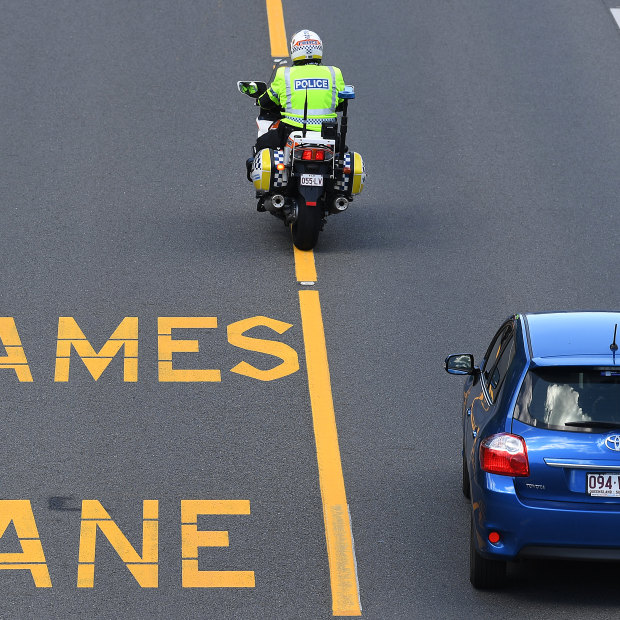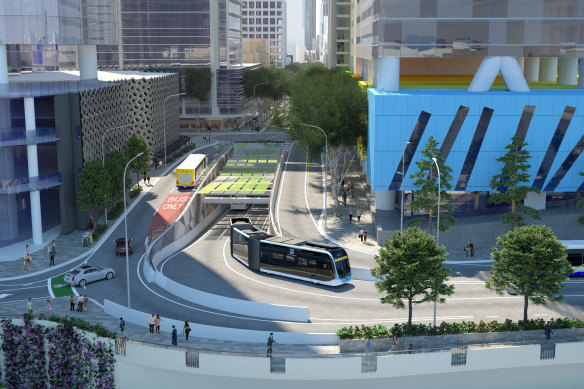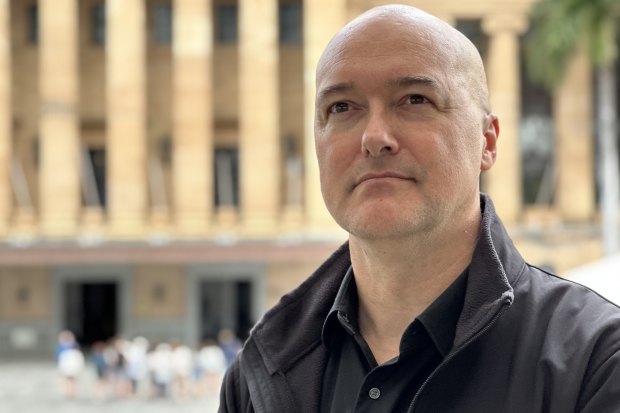This was published 9 months ago
How to ensure a smooth ride for the Brisbane Olympics
The window has closed on many Brisbane 2032 transport options, so what will it be like getting around our city during the Olympics?

Dedicated ‘games lanes’, such as this one in place during the 2018 Gold Coast Commonwealth Games, will likely be a feature of Brisbane 2032.Credit: Dave Hunt/AAP
Dedicated Olympic road lanes, deserted schools and workplaces, and a “ring of steel” around Brisbane, unseen since it hosted the G20 summit in 2014.
These are some of the predictions of Brisbane life during the 2032 Olympic and Paralympic Games as the city hosts one of the world’s biggest sporting events.
Brisbane Times has spoken to several planning and public transport experts who all agree that getting around Brisbane between July and August in 2032 will be a challenge, regardless of whether commuters are attending events at any of south-east Queensland’s Olympic venues.
Global planning firm Arcadis’ Brisbane chief, Paul Allan, said some international visitors would come to south-east Queensland expecting the same transport standards they enjoy at home.

The Brisbane Metro rapid transit bus system will be running by the 2032 Olympics.Credit: Brisbane City Council
“Being a regional Games, I think people have the perception they can stay on the Gold Coast [to attend] many events on the Sunshine Coast, and it’s only 150 kilometres,” he said.
“People forget [that] travelling that [route] by public transport, they can write off half a day or more.
“They look at a map and just presume transport here is like in Europe. It’s not.”
Making it easier will be Cross River Rail and the Brisbane Metro rapid bus system, which will both be operational come Games time.
But there is still a lament that more infrastructure will not – and can not – be delivered in time.
Public transport advocate Robert Dow, from Rail Back on Track, said although 2032 was still eight years away, the ship had already sailed on the prospect of major new rail projects, which can take years to deliver.
Even after a couple of false starts due to changes in government, Cross River Rail, for example, has taken more than a decade.
“We were quite excited [about the Olympics], initially. We thought we might have a chance of getting some real significant rail upgrades, particularly between the Sunshine Coast and the Gold Coast,” Dow said.
“Even Toowoomba, at one point, was in the mix, and it’s all just gone by the by ... it’s all been a bit of a con right from the outset.”
The good news? Professor Matthew Burke, the deputy director of Griffith University’s Cities Research Institute, is convinced south-east Queensland is on track to have plans in place to ensure a smooth ride.

Professor Matthew Burke: “There’s going to have to be some Queensland government office closures and some requests for the private sector not to run at full capacity.”Credit: Cameron Atfield
“There will be Games lanes [for buses and official Olympic transport] on a number of arterial roads and sub-arterial roads, and definitely, we will have a ring of steel in the city centre as well,” he said.
“There will be a security layer – we’ve just seen what that looks like [in Paris].
“I would expect some similar things to the G20 – maybe not quite as extreme as that, but similar things to that will be happening again.”
Burke said he expected schools, TAFEs and universities to shut down during the Games, which would take some pressure off the public transport system.
“Tertiary students are one in six public transport users, so we know they’re just not going to be doing their usual travel,” he said.
“But for workers, we really don’t know what the change in behaviour will be. If everyone was trying to get to the city centre to their offices at the same rates, we’d be in huge trouble – we wouldn’t be able to do it.
“So there’s going to have to be some Queensland government office closures and some requests for the private sector not to run at full capacity, just to allow that public transport capacity to be made available for the Games.”
Toronto-based civil engineer Margaret Parkhill, the mobility advisory business unit leader at Arcadis, said buses would do the heavy lifting.
“The nice thing with buses, you can build it faster, and that helps manage your cost because it’s not going to take 10 years [to build the infrastructure],” she said.
“You don’t get that cost escalation over time. You can get it done in a couple of years.”
Dow agreed, saying the only option left on the table was to have buses shuttling spectators along dedicated priority road lanes.
“QSAC [the Queensland Sport and Athletics Centre, selected by Premier Steven Miles as Brisbane 2032’s main Olympic stadium] was used for the Commonwealth Games … [in 1982] and we had shuttle buses from Banoon and Sunnybank railway stations,” he said.
“If that venue is used in 2032, it’ll be exactly the same as it was 50 years ago, which indicates that transport planning hasn’t been a real highlight of the Olympic Games planning at this point in time.”
Parkhill said any big undertaking, “whether you’re building a house or planning for an event like the Games”, required meticulous planning.
“You’ve got to get athletes to and from venues, you’ve got to get media and volunteers where they need to go,” she said.
“There are also a lot of goods that we need to get moved around – think of all the TV cameras and equipment that the Games will require. It’s moving the people around, as well as getting the goods where they need to go.
“All of that is going to require really good integrated planning across all transport modes. We do have to think about trucks, as well as cars and people and trains and buses, and integrating across a lot of the different stakeholders.”
Parkhill said it was important that Brisbane learnt from other major events between now and 2032, such as the 2027 Rugby World Cup.
“It’s hard with transportation to experiment, and the computer models only take us so far,” she said.
“But you could start testing a few different things and then seeing what works and what doesn’t, and make adjustments before the Games get here.
“It’s a good opportunity to take advantage of those other events.”
Start the day with a summary of the most important and interesting stories, analysis and insights. Sign up for our Morning Edition newsletter.